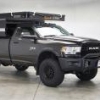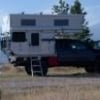Very interesting thread - thanks to all who have shared first-hand information.
My question is how to design a water system that is operational below freezing?
It seems as if we have two different parties to consider - those who will leave heat on all night and those who will not. There also seems to be two primary areas to consider. Area one would be the water tank itself while area two would include all the water lines, valves, pump, fittings, etc.
Maybe a simple solution for area two (water lines, pump, etc.) would be to have the ability to drain or pump the entire system back into area one (water tank) so now we are only fighting one battle. I am not familiar with plumbing so please excuse my suggestions but maybe this is a simple as having some sort of valve at the lowest point just above the tank that will permit the system to vent and drain all the water back into the main tank? Or maybe a valve that would prevent more water from being picked up from the main tank and now use the pump to pump all of the water back into the tank through a purge line?
Provided we are successful with draining all of the water back into the main tank now we no longer are worried about the pump, water lines, fittings, etc. since they are filled with air. So let's look at the most energy efficient way to prevent the main tank from freezing. We know that water will not freeze if it is moving so maybe some type of aeration system? Farmers use windmill driven aerators to keep ponds from freezing. The marine industry uses bubbles along the hulls of ships to keep that area from freezing and crushing the steel hull. If I have an air system onboard already with a five gallon tank at 150 PSI maybe I could have an aeration system plumbed into my main tank and use a slow release of bubbles to prevent the tank from freezing?
Not sure how many hours a system like that would last or how many bubbles are actually required for a given volume of water or maybe surface area is the key metric? I have no doubt that this area has been researched and many experiments have been performed so the information is out there. Maybe even a very small low draw DC powered water pump inside the main tank just to keep the water moving - like a fountain spraying up inside the tank itself?
My goal is to build a water system that can be used during freezing conditions when needed. Once I am done using it the system can be placed back into a hibernation mode where it consolidates all the fluid and keeps it from freezing. I spend much time in freezing conditions and I would like to design and build a water system that can be used below freezing temperatures.
BTW - I know many take external and internal temperatures but is anyone actually taking the temperature of the water inside the tank? That is critical information to have. Maybe a trigger that when the water temperature drops below 35 degree Fahrenheit the system becomes operational.
Edited by ramblinChet, 23 January 2022 - 04:14 AM.














